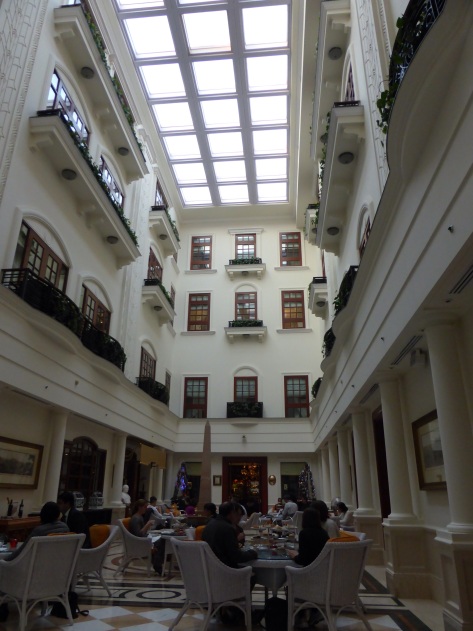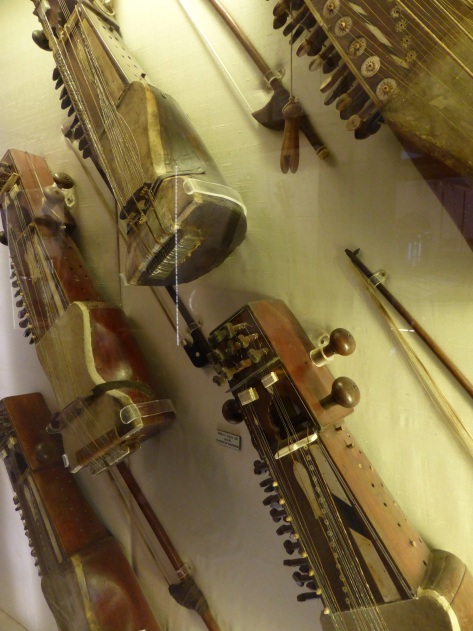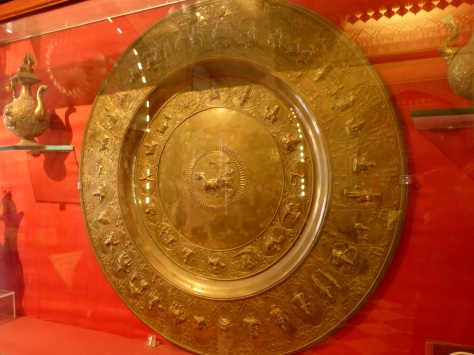India.
It was only supposed to be a three week holiday.
I was only supposed to blow the bloody doors off.
The more I read about this diverse and mesmerising nation, the more warning phrases started popping up saying that you need time to fall in love with it.
I really want to fall in love with it.
So, I purchase a one way ticket instead of a return and joyfully shake off a year’s worth of dust from my shelved backpack. Jess and Laura are to be my travel partners in crime for the first fortnight for a whistle stop smash-and-grab of the country’s highlights. But afterwards, with time stretched out languidly before me, I can take India at my own pace.
To kick things off, we’ll be swooping in on the triumvirate of cities which is the usual introduction for the first-time visitor to India, known as the Golden Triangle. Delhi, Jaipur then onto Agra.
We arrive in the sprawling capital of Delhi, the world’s second largest city at 25 million. During the flight, my manageable winter head cold has incubated into more of a chest infection, so between this and our extreme jetlag, our time in Delhi is heavier on the smash than it is on the grab. I console myself that there will be time to return. We settle ourselves in amiably by taking afternoon tea in the Atrium of Raj-era hotel icon, The Imperial.
It’s a very British start to our trip, and we follow it up with a drive around Delhi’s colonial heart at Connaught Place, taking in India Gate and the Government buildings. It couldn’t be further from the rest of the city. Pomp, serenity and stateliness completely replaces grit, hubbub and fervour.
But we’re most open-mouthed at the traffic. From all directions, at all speeds, with no regard for the usual mirror-signal-manoeuvre nonsense, there is an odd emphatic harmony to its insanity. We quickly come to realise that all modes of transport have their quirks in this country.
And before long we’re sampling the quintessential travel experience of the subcontinent, India by train.
Everything you’ve heard about the Indian railways is true. It’s all rather infuriating. There are something like twelve different classes to choose from. You can either book trains in (good) advance through Cleartrip, or go to the station 24 hours before to secure one of the tickets that are released on the day. The former is by far the easiest way, but it does take a little spontaneity out of the backpacker experience. Thankfully, we’ve had tour manager supremo Laura taking the sting out of the tail for us by booking our journeys in advance. Before we know it, we’re off to Jaipur, Rajasthan’s glorious capital.
There is the small matter of Hogmanay to start off proceedings. We upgrade ourselves to a full five star experience to enjoy the festivities. A gala dinner and masquerade ball is prepared in the courtyard…
…while we drink Margaritas as big as our heads.
A colourful buffet awaits us…
…accompanied by some good old Hindi rock’n’roll (they even threw in a Ricky Martin and Bruce Springsteen cover for good measure, y’know, to amuse the foreigners.)
Then, there is drinking, dancing and merriment.
Indians are not big drinkers, and their eyes widen as we order our third round. The bar manager, Mr Vishnal, becomes our closest pal and mixes up off-menu cocktails for us. Throw in some fire-throwing and the scene is set.
I’ve got a bloody good feeling about 2015.
Our first touristic foray takes us to the city’s Amber Fort, a former royal palace made of pink sandstone and white marble which sits on a hill looking over Maota lake.
Its former resident would have been the maharaja and his 12 wives. But as we climb the steep hill, we soon meet the current residents…and there’s a lot of them.
The fort has an impressive facade and four main courtyards and stunning views out over the city.
The Jai Mandir (Hall of Victory) is lined with white marble carvings and multi-mirrored panels. If you shine a torch upwards, you set off a little live light show.
The Diwan-i-am (not to be confused with Will.i.Am) is the Hall of Public Audiences where the public could air their grievances to the maharaja in the hope of reconciliation.
Then there is the Jaleb Chowk courtyard where the army returning from war would show off their spoils. From the 16th century until as recently as 1980, a goat would be sacrificed here every day. The women would be allowed to look upon the events of the Jaleb Chowk only from latticed windows above the courtyard.
But most hilarious is the Zenana (the women’s quarters) where the maharaja’s twelve wives would live. It was designed with underground tunnels so that the maharaja could make his nocturnal visits without anyone knowing which wife he had chosen for the night. There weren’t even any doors in the complex, lest they creak and give away any clues in the dead of night. The women did not even socialise or eat together, destined to spend their time alone waiting for their man. It was considered very auspicious to be ‘selected.’ What a difference four centuries makes.
On the way out, some of the locals wave us off.
Next stop is the Hawa Mahal (Palace of the Winds) which was built in 1799 by Maharaja Swai Pratap Singh to allow the women of the palace, constantly under lock and key, to have a better view of life in the city and its many processions.
It has become the emblem of Rajasthan’s capital, crafted like so much of the city in pink sandstone, giving it the nickname of the Pink City.
There’s time for a brief pause at the Jal Mahal (Water Palace) in the Man Sagar Lake before we head on the Central Museum.
Having spent so much time on the hoof (as it were) I’m always pleased when an audio guide has been produced by Narrow Casters. They’re are always so well put together, and have been rightly trusted at sites like Pearl Harbour, the Killing Fields and also here in Jaipur’s Central Museum. It takes us through an atmospheric run down of the sculptures, paintings, musical instruments and tribal dress.
There’s even a 10th century black stone carving of Vishnu, the supreme being and preserver of the Hindu triad, with his respective deities Brahma (creator) and Shiva (destroyer) at either side.
Then there is Ganesha, son of Shiva and Parvati, who is considered the remover of obstacles.
For reasons unbeknownst to me, the overlords of my catholic education considered Jesus the ultimate and only religious study required (with a side of Mary and lashings of Joseph of course) so Hinduism is a religion I’ve never known much about. This has whet my appetite, and the next book shop we pass will hopefully be up to the brief.
The museum is housed in the rather glamorous part-English, part-North indian Albert Hall with inspirational quotes in both English and Sanskrit over each of its ornate archways.
Another train ride, bite-size and manageable at 4.5 hours, awaits us to Agra in Uttar Pradesh, the home of the Taj Mahal, oft mistakenly considered as one of the seven wonders of the world. Wondrous? Yes. Officially an ancient wonder, not so much.
So it’s a tourist-heavy stop on a well-trodden route, and the aggro levels on arrival at the railway station seem to be directly proportionate. It is by far the worst we’ve seen and negotiating our way out of the station, into a tuk tuk and onto the hostel is a real chore. Irritatingly, north India is having what we’d call in Scotland “a cold snap”, and we’re ill prepared for the freakishly cold temperatures.
The Taj Mahal is the ultimate love story. Boy meets girl and makes her his third wife. Girl produces thirteen healthy children but dies in childbirth with the fourteenth. Boy promises to build girl a fitting mausoleum in tribute and love for her. Twenty two years later, the Taj Mahal (Crown of Palaces) is completed and considered the most significant in Muslim architecture. Boy’s son overthrows him, places him in nearby fort until the end of his days then, rather poetically, buries him next to girl.
It’s creator Emperor Shah Jahan, who built it for his wife Mumtaz Mahal, said its beauty “makes the sun and the moon shed tears from their eyes.” Two and a half million people each year come to see if there is any truth in that.
Sunrise is the best time to view it, so we shuffle out of our hostel in the wee small hours, torches at the ready, to walk down to the most accessible gate from where we are staying in Taj Ganj, the East gate.
The entry point is laughable. After a bag scan, they try to take our torches from us (which wouldn’t be a problem if it wasn’t my trusty event Maglite.) When we protest we’re told that the batteries are the problem. We now understand the synergy between the East gate and it’s many battery stalls outside, it had flummoxed us until now.
When they try to take Jess’ emergency Twirl, all hell breaks loose. We counter that she’s diabetic, patting our tummies by way of explanation. It just comes off as ‘hungry’ and it’s the last we see of the snacks. They agree to store our items, but when we ask how we’ll collect them we’re told we will be ejected if we ask any more questions. Sure. Radge Mahal.
Once the formalities are out of the way, we scoop up our audio guides for our first glimpse of this (unofficial) wonder.
D’you see it? You might need to squint a bit.
The haze hampers our mission, but the morning sun starts to burn through it and that’s when we start to gasp in awe.
Thirty-five different precious and semi-precious stones were used to create the marble inlays of the palace, the Pietra Dura.
It’s flanked either side by four minarets with its back, remarkably a mirror image of the front, overlooking the Yamuna river which is considered sacred by Hindus. The mosques look on from either side, also with ornate red sandstone work.
It’s starting to fill to the brim as the tourist coaches arrive from Delhi, so it’s time to get our covered feet out of here.
We stop in at Joney’s Place for a brief refuel of Masala Omelette and Banana Lassi.
After breakfast it’s a thirty minute walk to Agra Fort which is just along the Yamuna river, in full view of the Taj Mahal…on a clearer day. It was built by Emperor Akbar in 1565 but was modified by Emperor Shah Jahan later, he just could not get enough white marble so he embellished the fort with it.
The residents here are a little camera shy.
Then we have our first truly outstanding Indian meal, at Dasaprakash on Gwalior Road. We basically only order things we have never heard of before, so it’s an epic voyage of culinary discovery.
A dander around Sadar Bazaar, and our golden Triangle experience is over.
It has been a baptism of fire, we did in under a week combatting chest infections, Hogmanay-worthy hangovers and extreme jetlag. But we are triumphant. Next stop Varanasi.
And the soundtrack was:
Sufjan Stevens ‘Seven Swans’
Ricky Martin ‘La Vida Loca’ (forcibly)
The Killers ‘Glamorous (H)Indie Rock and Roll)’
Bruce Springsteen ‘Born to Run’
Robert Burns ‘Auld Lang Syne’



























































Fantastic read!